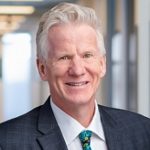 By Nick van Terheyden aka Dr Nick, Principal, ECG Management Consulting
By Nick van Terheyden aka Dr Nick, Principal, ECG Management Consulting
Twitter: @drnic1
Host of Healthcare Upside Down – #HCupsidedown
If you’ve ever taken “the Tube,” you’ve heard it. Even if you’ve never been to the United Kingdom or availed yourself of its underground rapid transit system, you’re probably at least familiar with the phrase.
“Mind the gap.”
Episode NOW on Demand
The directive is an automated message advising riders to take notice of, and avoid stepping into, the space between a rail carriage and the station platform. At its core, the phrase is purely functional—failure to mind the gap could result in serious injury. Its international popularity probably has something to do with the sense of novelty so many tourists find in British vernacular.
But the reason “mind the gap” has evolved far beyond the realm of public transit is because of its applicability to all manner of real-world situations. It’s a pithy reminder to be aware of life’s pitfalls.
And our healthcare system is full of them.
One of the more glaring gaps occurs during the closing moments of a doctor’s appointment. After reviewing lab tests, developing a care plan, and prescribing some therapy or drug, the physician asks the patient if they have any questions. It’s an obvious query, and a genuine one; but for a stressed patient who’s had to absorb a great deal of information in a small amount of time, formulating thoughtful questions can be difficult.
Some might remember in times gone by when those questions you forgot to ask could be posed to your local pharmacist, who not only knew you by name but also knew your medical history, the treatments you had received, what had worked, and so on. But like many elements of healthcare, today even this is a transactional activity.
Tony Willoughby is trying to change that. The CEO of Stellus Rx joins me to talk about integrating pharmacists into care teams and bringing healthcare back to its community roots. Below are a few excerpts.
The fee-for-service treadmill.
“We have all this anxiety going into a physician’s office. We share our chief complaint, the physician does their best to assess and come up with a clinical plan, and they have to get to the next exam room. They always ask, ‘Do you have any questions?’ We get stuck like a deer in headlights and say, ‘No, not right now’…right until we get to the car. Then all the questions start flooding in. We go to a pharmacy and get put in a cattle queue. [Eventually] they’ll ask us if we want to talk to a pharmacist. If we say yes, a pharmacist who’s understaffed, running on the same fee-for-service treadmill as a physician, ultimately reads warning labels to us. And we just allow that to go on and on, with little coordination of the patient’s experience.”
Closing the gaps.
“Our approach at Stellus Rx is to try to eliminate [those] barriers and the constraints. We’ve aligned pharmacist-led teams with primary care physicians so that there are real-time handoffs and coordination that extend beyond the exam room and expand the capacity [for] the patient voice. The pharmacist co-collects [patient] information and works with the physician to come up with an optimized plan. Our pharmacists work panels, just like the physicians do. Once a physician is connected to a pharmacist, and once a patient is connected to a pharmacist, that’s set as a team. So when there is confusion in a moment that matters with that patient, they have this direct contact to a pharmacist.”
A return to value.
“We shouldn’t call it a transition to value-based care—we should call it a return to value-based care. It’s a return to establishing community, where you know it’s not just the next transaction.
Nobody goes to medical school or pharmacy school saying, ‘I can’t wait to see how many transactions I can interact with a day’.”
This article was originally published on the ECG Management Consulting blog and is republished here with permission.
About the Show
The US spends more on healthcare per capita than any other country on the planet. So why don’t we have superior outcomes? Why haven’t the principles of capitalism prevailed? And why do American consumers have so much trouble accessing and paying for healthcare? Dive into these and other issues on Healthcare Upside/Down with ECG principal Dr. Nick van Terheyden and guest panelists as they discuss the upsides and downsides of healthcare in the US, and how to make the system work for everyone.
Tune in weekdays at 9am, 5pm, and 1am ET.
Join the conversation on Twitter at #HCupsidedown.
